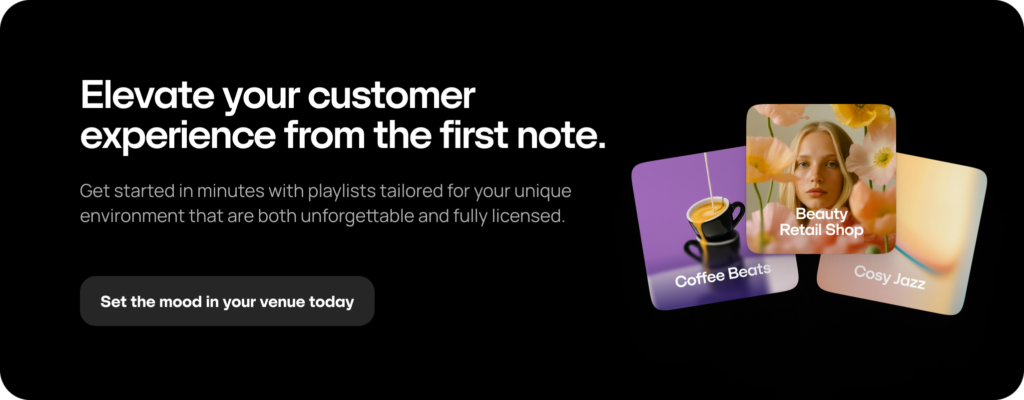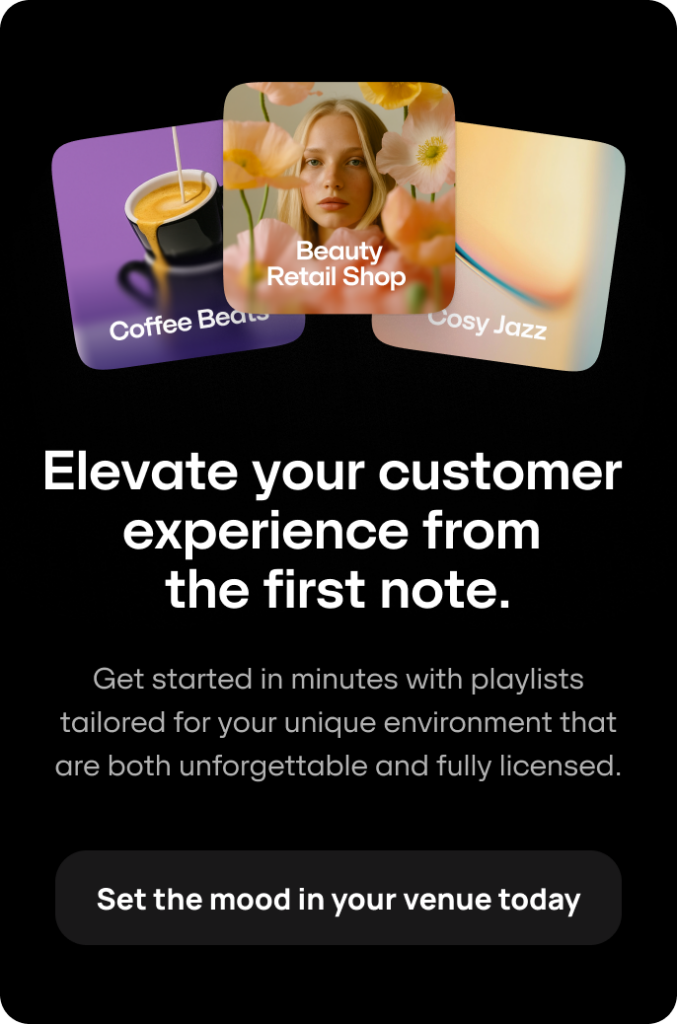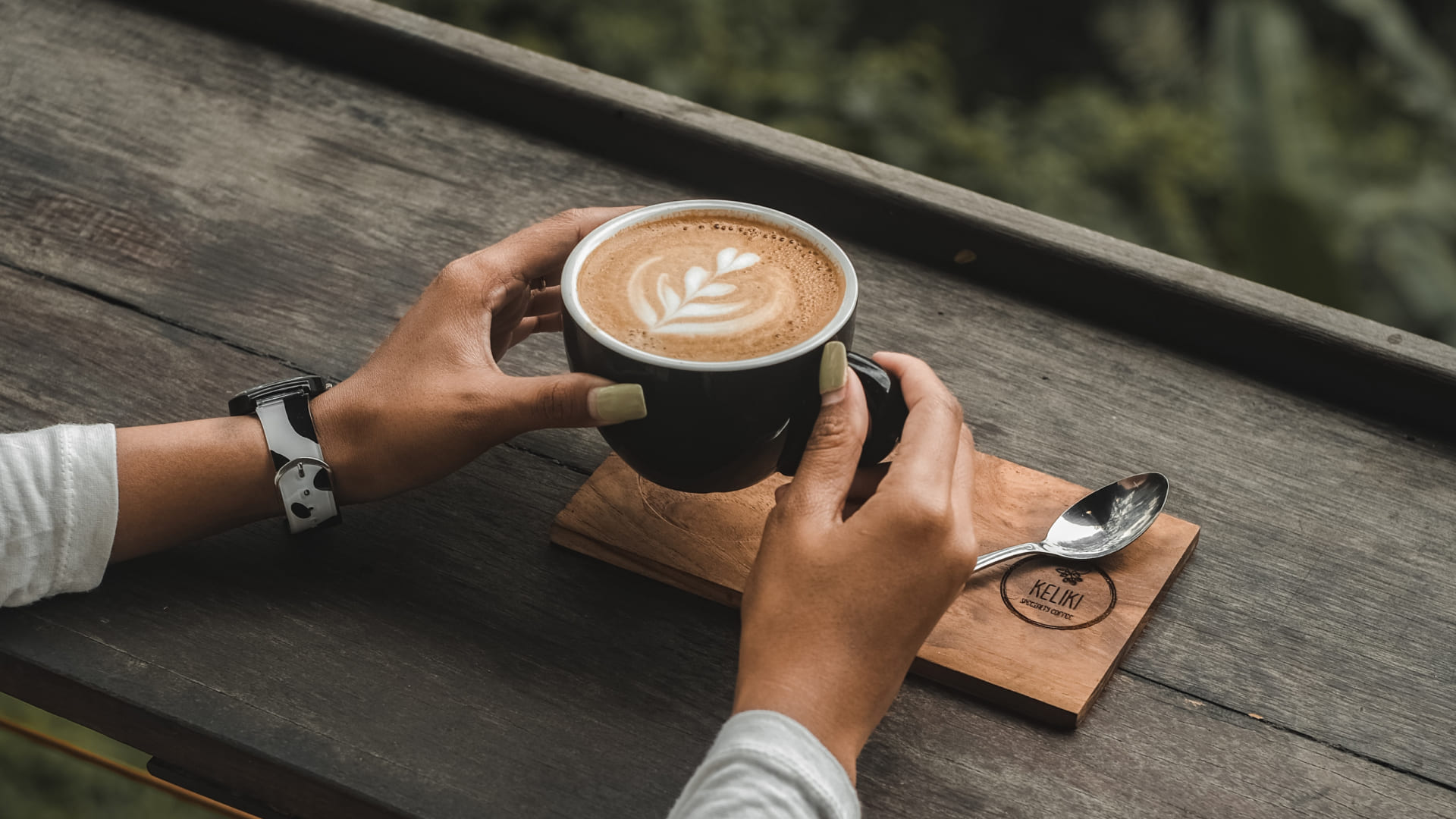3 examples of using music to empower food & beverage brands

Music has a significant impact on our lives, evoking various emotions and associations. Having a psychological effect on people’s minds, music can even influence consumer behavior, for instance, purchasing decisions, time spent at a public venue, and even the speed at which diners take food.
If used properly, background music for business can help establishments increase sales. Restaurants playing tailored music that reflect their culture can boost the sales volume by more than 9%, as found by HUI Research. A survey of over 2,100 restaurant visitors determined that brand-fit music improved guest satisfaction and sense of well-being rather than when they were listening to random hits.
According to MRC, 65% of participants revealed that creating a compelling ambiance through music is crucial to venues. The study says that 54.9% of respondents have stayed longer at a public place because of the music. Therefore, playing music is vital to build customer loyalty, provide a memorable experience, and develop brand identity.
In this article, we will consider the examples of how bars and restaurants use background music. Learn how to make music an effective tool to communicate your story, engage the audience, and stand out from rivals.


How venues use background music for business
1. Pavillon Bar & Kitchen
Based in Switzerland, Pavillon Bar & Kitchen is a popular bar that offers quality interpretations of cocktails, classic dishes, and late night pizza. Established in 2016, the bar was started on the site of the former ice cream shop from the 1980s.
When opening Pavillon, the owners aimed to reach out to a wide audience by providing a place that adapts to any time of day and situation. For instance, the founders wanted to make the venue perfectly suited for either a morning coffee, or a pleasant lunch, or a warming afternoon tea, or original evening cocktails.
This way, Pavillon Bar & Kitchen needed to stream different background music, ensuring that it meets various guest preferences and keeps them engaged.
During daytime, the company decided to use a music playlist with vocal familiar songs. For aperitif time, Pavillon’s choice is jazz and soul. In the nights and evenings, the establishment cooperates with DJs playing genres like funk, hip-hop, and techno.
It is worth noting that George Marchant, the head of Pavillon, prefers to curate music playlists himself, with the help of professional DJs. By playing tailored background music for the bar, Pavillon Bar & Kitchen improves the audience’s satisfaction and drives sales.
“Music curation is a growing need and a business that ultimately creates atmosphere, identity, branding — which all result in that X factor: loyalty.” —George Marchant, the head of Pavillon.
If you’re wondering how Pavillon Bar & Kitchen designed a distinct brand identity by bringing together food, interior, and music, read our article on the topic.
2. Tin Drum AsiaCafé
Tin Drum Asiacafé is an Atlanta-based restaurant chain of 10 locations featuring Pan Asian cuisine with over 35 dishes and 15 proprietary sauces. As part of its unique selling proposition, the chain provides a gluten-free menu and vegetarian items.
The owner of the restaurant Steven Chan loves music and art. He believes that restaurant background music is an integral part of the food and beverage place. To create a unique awesome atmosphere, Steven analyzes a music playlist for restaurants as precisely as he analyzes his revenue to come up with a perfect tune selection.
When choosing what kind of tracks and compositions to stream, Steven Chan relies on music’s psychological effects on customer behavior, not picking from Billboard’s Top 100. It is proven that music can impact heart rate and consumers are more excited with purchases when it is raised slightly.
That’s why 65% of music played in Tin Drum Asiacafé has a tempo of 120 beats per minute, which helps keep visitors engaged, happy, and lighthearted. Since people prefer variety, the venue’s owner includes songs with either slower or faster tempo in the restaurant’s playlist.
Interestingly, Tin Drum Asiacafé was named after the tin drummer who entertained residents of ancient villages with his drum. So, Steven chooses drum and bass tunes. In fact, this line is prominent and is mixed with organic, non-electronic, and other music. Steven Chan says that his background music for the restaurant improves the overall customer experience and brand recognition.
3. The Great Escape
Established in 2003, The Great Escape is one of the most well-known bars in Lausanne, Switzerland. The food and beverage venue is especially popular among local citizens, expats, and students.
The bar specializes in burgers and beers, offering a wide range of choices for customers. The Great Escape is a great place for sports fans, showing football leagues, rugby competitions, and other sports games.
In order to create brand identity, the establishment took into account all aspects, from interior design to drink design and menu decoration. Background music for the bar serves as a glue that connects all elements.
Seb Kummer, a co-manager of The Great Escape, adores background music management. Aiming to satisfy the needs of the international crowd, sports fans, and beer-loving guests, Seb Kummer created a music library with more than 45,000 songs.
Our clientele identifies their experience via the music, this is one of the main factors that ensures their loyalty,” says Seb Kummer. “We don’t specialize in EDM* or techno, but rather an ear-friendly alternative rock, singer-songwriters and familiar drinking favorites like Bob Dylan, Johnny Cash and John Mellencamp.”
Final thoughts
Background music management has become an important part of a food and beverage-industry transformation. Music is the ultimate glue connecting all the other components such as cuisine, interior design, menu, and client service to create a delightful memorable atmosphere.
With tailored background music for bars and restaurants, it is possible to encourage the desired customer behavior and evoke certain emotions, thereby increasing the purchase amount and boosting guest satisfaction. This is also a perfect way to strengthen brand identity and gain a competitive advantage.


